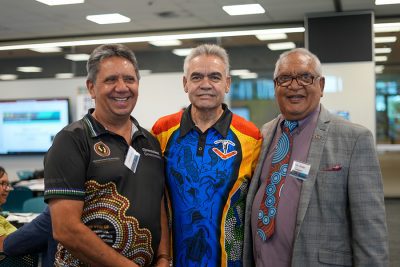Co-design with Aboriginal and Torres Strait Islander people and communities
We acknowledge that, in Metro North Health, we work on the lands of the Jinibara, Kabi Kabi, Turrbal and Yugara peoples, and that Aboriginal and Torres Strait Islander people were the first to use co-design to establish methods of working and living that work best for their community.
Current inequities in health care access and outcomes for Aboriginal and Torres Strait Islander people can only be addressed by health system reform that empowers Aboriginal and Torres Strait Islander people to make decisions about the design and delivery of health care. This will only succeed by listening to and respecting the voices, lived experiences and cultural authority of Aboriginal and Torres Strait Islander peoples.
This is now mandated in the Hospital and Health Boards Act 2011, with the “Making Tracks Together” Health Equity Framework outlining Queensland Health’s commitment to co-designing a world class, safe and equitable health system with Aboriginal and Torres Strait Islander people.
Tips for co-design with Aboriginal and Torres Strait Islander people and communities
Metro North Health recognises that achieving improved health outcomes for Aboriginal and Torres Strait Islander communities requires a substantial shift to genuinely listen, understand and acknowledge the systems and our approach for the need to change.
 Metro North Health has a legislated responsibility and is committed to co-designing the health equity strategy with our Aboriginal and Torres Strait Islander community and partners which will be an ongoing journey to create change to our health care services by 2031.
Metro North Health has a legislated responsibility and is committed to co-designing the health equity strategy with our Aboriginal and Torres Strait Islander community and partners which will be an ongoing journey to create change to our health care services by 2031.
We acknowledge the need to increase the understanding of co-design with our Aboriginal and Torres Strait Islander community to enhance stronger connections that builds and sustains relationships.
If you are looking at co-design with the Aboriginal and Torres Strait Islander people and communities, we recommend the following tips and resources as best practice for successful engagement:
Co-design tips
- The project should be led (or at least co-led) by someone who identifies as Aboriginal and/or Torres Strait Islander origin. Governance and decision making within your project should support co-governance and co-ownership of both the process and the outcome.
- Ensure that at least half of your co-design team identify as part of the community you are working with (e.g. 4 of 7 members of the co-design team identify as Aboriginal or Torres Strait Islander). This includes both consumers and staff.
- Acknowledge unconscious bias and racism. This video may be a good way to reflect on and start a conversation about racial discrimination and institutional racism within your team.
- Identify people with relationships with community to facilitate engagement. There will be people with these relationships within your health service or directorate, so seek them out and invite them to be involved. They may already have events or forums to meet with community e.g. regular yarning circles.
- Use a peer-to-peer model of engagement – Aboriginal and Torres Strait Islander staff or community members to connect and engage with the community.
- Build relationships first, co-design second. Connect with people and get to know each other, without an agenda, and let the co-design come from that.
- Don’t design in the background – put everything on the table, support others to do the same, and allow yourself to be guided by your community experts.
- Consult with members of the community to overcome potential barriers to engagement. These may include language/jargon, financial, access, cultural safety and previous experiences.
- Don’t “fly-in, fly-out”. Ensure there is a flow of information about progress or changes back to community. Be honest about any issues or barriers, truth-telling is the key to relationships.
- Watch this video on Co-designing Health Equity with Aboriginal and Torres Strait Islanders peoples from a Metro North Board Community Engagement Forum.
Supporting resources
- Seek to understand and respect the cultural and social determinants of health (Our Health, Our Journey, Our Way)
- Use the guiding principles of cultural respect and recognition, communication, relationships and partnerships and capacity building from the Queensland Health Aboriginal and Torres Strait Islander Cultural Capability Framework 2010-2033 (internal access only).
- Consider appropriate communication techniques and appropriate terminology prior to engagement and ensure cultural capability training is up to date.
- Consult with your facility cultural capability officer for guidance and support when engaging with the Aboriginal and Torres Strait Islander community.
- Consider strategic guidance and advice from the Metro North Aboriginal and Torres Strait Islander Leadership Team when initiating a co-design project or program.
- Familiarise yourself with the Healthy Equity agenda. Consider how your co-design project can help to work towards health equity, eliminating institutional racism across the public health system and achieving life expectancy parity for Aboriginal peoples and Torres Strait Islander peoples by 2031.

